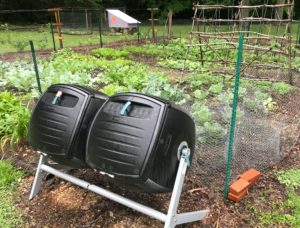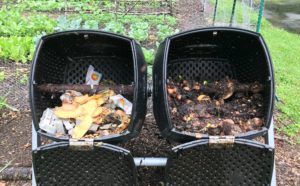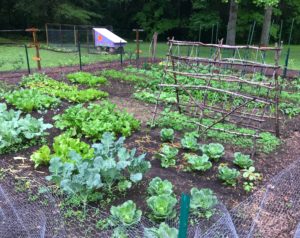
My Lifetime double barrel composter that resides near the garden. It was actually assembled upside down, but it still works fine.
I’m often asked how to compost, and I really cannot express the ease at which composting can be done at home. Some people will tell you that you need a 4:1 ratio of brown to green matter and that falling short of this perfect combination results in failure. Let me just say that this is total bologna. Yes, ideally you would take great care into creating the most nutritious, brown goodness possible, but let’s be honest, not all of us have the time, energy, or even resources to make that happen.
An Ideal Compost
When you consult the Google on how to compost, the Google will tell you (among other things) that you need:
- good air flow (turn your compost frequently; this one’s true)
- protection from animals (I have to fully agree with this as well)
- brown material (about 70 – 80% of your pile)
- green material (about 20 – 30 % of your pile)
Green materials include:
- fruit and vegetable scraps
- plant trimmings that are still green
- coffee grounds and tea bags
- garden weeds
- manures
Brown materials include:
- hay or straw
- dried grass clippings
- dried leaves
- sawdust or wood chips
- twigs
- cornstalks (dried)
- cardboard (not the shiny stuff) and paper
You can use hay bales as borders to create a compost heap, old pallets, expensive composting bins (I have one and I love it!), less expensive composting bins (I think these are probably a waste of money), or just heap it onto the ground. I will say that my Lifetime double barrel 50 gallon (100 gallons total) composter is amazing. I would never buy one of the single barrel models, because you add to one side while the other side is decomposing. If you have just one barrel, what do you? Stop composting during those 4 months that you’re waiting for it to decompose? The barrel composters allow you to easily turn the compost, and it’s kept safe from animals that may want to make a habitat of your pile. We had a skunk family make a home in our Vermont compost, which is what prompted the double barrel composter purchase in the first place. It’s a long story, but we ended up trapping skunks in a Havahart trap and transporting them in the back of our station wagon. The feat was complete foolishness, but anyways… back to composting… a friend has had rats in hers (I doubt she transported these in her car). Neither of these rodents are friends that you want to attract to your yard, especially in close quarters.
And just a quick plug about the sturdiness of my double barrel composter: it has been attacked by a black bear twice and is in perfectly good condition. (I should really write a review, shouldn’t I?)

The bin on the right was completely full about 1 – 2 months ago. I am now adding food and paper scraps to the left side.
Decomposition Duration
Ideally, you mix together the appropriate ratios of green and brown materials, turn these materials frequently to allow air circulation, and allow the mixture to decompose for about 3 – 6 months. The exact duration needed to allow a compost to fully decompose depends on the products that you’ve added to the compost. For example, the addition of chicken manure requires a minimum of 6 months to age in order to prevent burning your plants with excess nitrogen. A mix of vegetable scraps and leaves will take less time, but all of this depends on the ambient temperature. Yes, compost generates heat, but it’s a simple fact that microbes are less active in the winter months when it’s colder outside. My compost seems to massively accumulate over the winter and just barely decomposes before I run out of space.
I’ve been known to spread partially decomposed compost into the garden when I either need the fertilizer or I need the space in the bin. The organic matter will continue to decompose no matter where it lives, so you don’t have to be completely picky about this unless you choose to do so. I’ve even known people who dig a ditch in the garden, fill it with food scraps (no meat), cover it with soil, and plant their seeds directly on top. My only gripe with the partial decomposition is with egg shells. I have egg shells scattered throughout my garden and decided to cut way back on my egg shell additions till the situation clears itself up a bit. Can there be such a thing as too many egg shells? I’m not sure, but I was about to find out. I’m going to instead try mixing the shells into my chicken manure piles that are to come.
How to Compost: A Realistic Approach
Okay, so here’s my problem with the perfect compost system: I don’t have enough brown material on a regular basis. I have tons of vegetable scraps, but that makes up the majority of what goes into the bin. I add leaves in the fall, but that addition is limited to just a few short months. I don’t use hay in the garden and I’m not going to start buying it just to mix into my compost heap. We have some sticks lying around, but I don’t want to fill the bin with sticks… it’ll take too long to decompose. My addition of brown material is limited to paper, cardboard egg cartons, and occasionally some cardboard.
There are times when I am so far from reaching this magical brown to green ratio that I question the quality of whatever I’m creating, yet decomposition knows no bounds… the stuff rots anyways. The overly greened compost will at times become too wet (or stinky – this is my sign that I’ve added far too much nitrogen in the form of green matter and need some carbon [brown matter] to absorb it) and this is my signal that I really must find a load of cardboard or paper before it becomes water logged, anaerobic, and even stinkier. The stink, by the way, is a result of excess nitrogen that will off gas when there’s inadequate carbon. But overall, I just throw whatever I have in there and let it do it’s thing.
One of the most brilliant things that I throw into my compost are paper items that need to be shredded. Bank statements or other pieces of mail with valuable information don’t stand a chance against the powerful microbes living in my compost heap. Tear the paper into pieces, throw it in the compost, give it a good turn, and it’s as good as gone. Voila!
I know that it sounds like I’m saying that the only way to compost is by using a composting system like my double barrel composter, but that’s not the case. I just really hated having skunks in my tiny, fenced in, Vermont yard. It made for a couple of terrifying nights. But there are many individuals who have been heaping compost in a pile on the ground with little to no issues for years. My suggestion is to start with the absolute easiest and least expensive option available and upgrade as necessary.
Advanced Composting
I’m sure that there are a handful of avid composters who are reading this blog and cringing at the thought of my haphazard approach to decomposition. There are certainly individuals out there who have created systems that are far better and nutritious than mine. You can even step up your game with composting tea systems using a vortex for aeration and time your creation with the moon cycles. It has and is being done, and some people swear by it. Some biodynamic farmers are taking compost to the next level by packing compost into ram’s horns, burying the compost for certain periods of time, and then removing the goodness when the time is right. I believe that energetic inputs on the part of these farmers is surely resulting in some sort of significant gain, otherwise they wouldn’t keep doing it. But, you don’t have to go this far if you just want a simple compost.
I see compost as a beneficial in 2 ways. First and foremost, it cuts down on our waste production. This is probably my primary reason for composting. The second way in which compost is beneficial, as a fertilizer, is actually a fairly insignificant source of nutrients in the grand scheme of things. If I had a handful of raised beds the compost would be adequate, but that’s simply not the case. I haven’t accurately tallied my cultivated square footage, but I’d estimate that it’s around 2,000 – 2,400 sqft if I include the annual garden, blueberries, herbs, fruit trees, asparagus bed, and other perennial berries. Sure, the home compost is a nice addition, but it’s just a drop in the bucket. I’m hoping that the chicken manure will at least provide a bit more of what I need so that I’m not buying as much mushroom compost in the future.
How to Compost in Summary
Hopefully this helps you understand a bit more about how to compost and that it doesn’t have to be a perfect science; it’ll happen on its own regardless of what you put into the system. Sure, more effort is better, but don’t let this deter you from doing your own home composting system.

I am so relieved that composting can be easier. I think it is such a waste to send it to a landfill. After having purchased a composting container at Sam’s I was thrilled to get started. How hard could it be? Years later I am still waiting for the magical stuff. I had gooey for a while. Somehow I had missed the fax on adding brown stuff. We add ground up leaves now from our small yard when we have them-of course we never have enough for a whole year. I grind the eggs shells up with a retired coffee grinder into a powder so I don’t have all those shells around. Sometimes I just spread them in the yard. After finding your blog I am encouraged to forge on this spring!
Nice work, Betsy! You can always add paper if you need more brown material. I always run out of leaves, too.